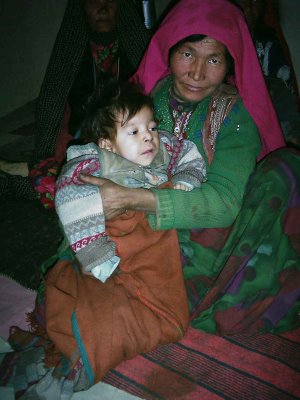

Mahbouba, Dr. Sami and I decided to take a well-deserved Friday morning off to climb up to the ruins of Shahr-i-Zohak. I remember seeing this stunning city carved out of red rock when I was a girl. When I saw it I knew somehow I had to return to Afghanistan when I was an adult and show my children this remarkable sight. I since then have only seen such beauty in the red rocks of Sedona. Climbing up the loose rock was challenging and about 2/3rds of the way, straight up (Afghans do not seem to use switchbacks on their paths-only for vehicles) I looked down and unexpectedly experienced vertigo and the intense desire to get back off the mountain immediately-especially as our path was lined with red rocks, the sign for "danger-unexploded land mines". Mahbouba was having as much difficulty as I was and we decided to press on to the top as we would never forgive ourselves for the opportunity to see this. Dr. Sami was obnoxious as any surefooted, macho, 26 year old Afghan male can be. He teased us relentlessly. It was on our way down that I could see the differences in cultures as Dr. Sami and Mahbouba, after weeks of needling each other and arguing, found comfort in each others chatter and laughter, whereas I grumpily declined Dr. Samis assistance and told them to shut up as I could not concentrate. I found relief in following our silent and sure-footed guide quickly down the mountain leaving them behind to enjoy a short truce as they kept each other company during the descent.
Nancy Hatch Dupree has written some of the most detailed descriptions of ancient places in Afghanistan. She says of Shahr-i-Zohak.
"This mass of impressive ruins was once the principal fortress protecting the entrance to the City of Bamiyan during the reigns of the Shansabani Kings in the 12–13th centuries A.D. The natural defenses afforded by the cliff had been recognized from much earlier times, as might well be expected. Archaeologists have found evidence that man had built defensive works here as early as the end of the B.C. era, and, when the Hephthalite Huns fought for possession and power within these mountains in the 6th century A.D., there was a considerable complex here. The present remains, however, are those of the fortress which withstood the advance of a Mongol army led by Genghis Khan’s favorite grandson in 1221. The resistance was stout and determined and during the melee on the plain at its foot, the young commander fell mortally wounded. In revenge Genghis Khan vowed to destroy the valley, which he did, most thoroughly.
Today’s visitors enter the fortress via the very pathway used by the original defenders and one can easily envision the passage of mounted cavalry, with all the attendant sounds, smells and confusion. On the way are attractively decorated towers for guards on duty. These towers had no doorways but were entered by ladders which were pulled up later to make the tower totally secure. There the soldiers stood on wooden platforms laid on heavy supporting beams, and shot their arrows through loopholes.
...city-fortress of glowing magenta, atop such cliffs, must of necessity have inspired romantics with tales of legendary kings and heroes. So it is not surprising to learn from the inhabitants of Bamiyan that this was actually, in fact, the royal abode of Zohak. A wilder occupant for this fairyland city could hardly be found.
Zohak first appears in the Shahnama as a noble prince of Arabia, a devoted son well-beloved by his people. He became, however, possessed of the Devil who induced him to usurp his father’s throne whereupon the Devil appeared disguised as a loyal subject who asked to kiss the new king on the shoulders in token of his complete submission. No sooner had he done so, and vanished, than two black serpents thrust their heads out from where the kisses had been placed. Attempts to cut them off only resulted in their immediate return and their increased demand for human brains, the only food they would accept.
At the same time that Zohak was being seduced by the Devil, civil war broke out in Iran and Zohak marched in as the champion of one faction and was enthroned as the emperor of Iran. For a thousand years his rule brought terror and chaos to the land, but then the hero Fraidun was born. After many escapades, Fraidun finally succeeded in taking Zohak prisoner whereupon he took the dragon-king to a far off mountain peak and left him there to die. The Shahnama ends the tale here but, typically, Afghan legend goes on to elaborate by saying that, deprived of their daily meal of brains, the serpents turned on Zohak, bit into his scalp and fed upon his brains until he died."

























